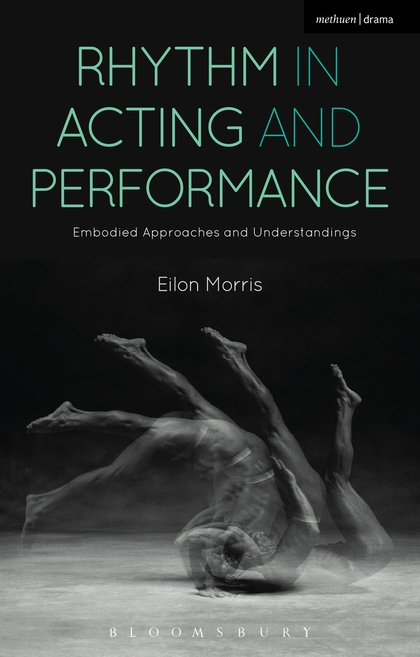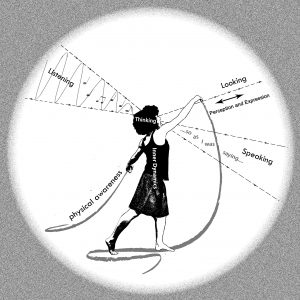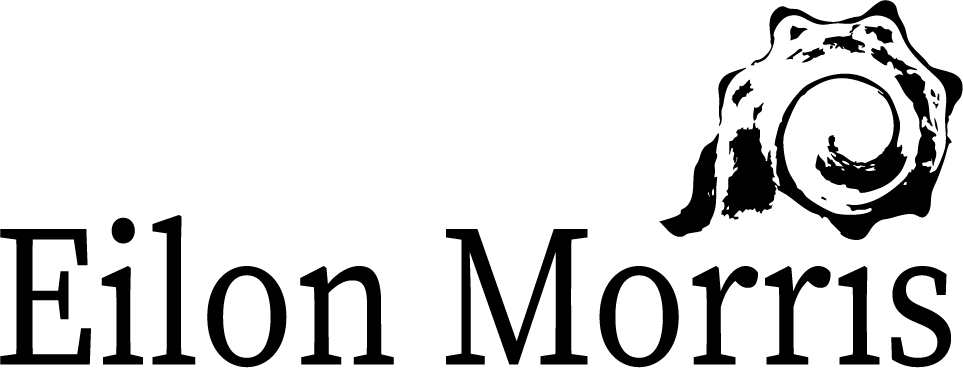
Rhythm in Acting and Performance: Embodied Approaches and Understandings, was published by Bloomsbury, Methuen Drama in 2017. It was written and compiled over an eight-year period, through enquiry, collaboration, discussion and play in the field of rhythm and performance. Informed by my own practical knowledge of working as an actor, percussionist, and educator, this text discusses the ways practitioners approach, embody and understand rhythm within their creative work and play.
To start, Eilon Morris informs the reader that they will not find a simple definition or universal concept of rhythm in this book. Instead, through a well-balanced dose of theory and practice… Morris adeptly unpacks the complex relationship with rhythm in training and performance. With risk of sounding overly effusive, as an acting instructor this is a book I have been wanting for years. Its value comes from Morris’s approach. … It will be a great addition to the conversations of acting instructors and artists in performance, but also for scholars looking to enrich the engagement of students in discussions of performance analysis.
J. Ariadne Calvano, Theatre Topics,
Rhythm in Acting and Performance traces this common and yet diverse subject through a range of contexts and perspectives, including the work of Konstantin Stanislavski, Suzanne Bing, Jerzy Grotowski, Anne Bogart, John Britton and the author’s own practices as a trainer and performer. Including topics such as ensemble, improvisation, voice, and ritual, this text examines these familiar performance themes through the lens of rhythm, emphasising rhythms role in uniting performers, inspiring vitality, shaping meaning and states of consciousness.

Offering informative and useful insights to aid and inspire further creative and academic explorations, and including case studies, practical examples, analytical reflections, and interviews, Rhythm in Acting and Performance is an ideal guide for students and practitioners.
Morris opens up this vital but neglected term with a multiplicity of approaches, ranging from historical context and practitioner analyses and interviews through 24 sample exercises to more philosophical reflections. This broad range is artfully grounded by his highly informed and embodied understanding of rhythm.
Paul Allain, Professor of Theatre and Performance and Dean of the
Graduate School, University of Kent
See more details and purchasing options at:
Bloomsbury Publishers: https://bloomsbury.com/uk/rhythm-in-acting-and-performance-9781472589866/
Amazon.com: http://www.amazon.com/dp/B073QJFMFR
Amazon.co.uk: http://www.amazon.co.uk/dp/B073QJFMFR
Drama Online: http://www.dramaonlinelibrary.com/theatre-crafts/rhythm-in-acting-and-performance-iid-184246
Table of contents
PART ONE Establishing a Pulse
-
-
What is Rhythm? An Open Question
The etymology of rhythm Productive categories of rhythm -
An Epoch of Rhythm: Now and Then
Natural and organic rhythm Mechanical and deterministic rhythmic aesthetics Rhythm as a universal language
Authenticity and real timeA new epoch of rhythm PART TWO Stanislavski on Rhythm
-
Tapping emotions: the Ins and Outs of Tempo-Rhythm
An aspiring opera singer Psychophysical techniques Eurhythmics and polyrhythm Tempo and rhythm – ins and outs Tempo-rhythm in training Tempo-rhythm in rehearsals PART THREE Structure and Spontaneity
-
Suzanne Bing: Music and Games in Actor Training
Initial interests in rhythm Children’s school in Paris Applying eurhythmics in actor training Voice, movement and storytelling Musique corporelle Legacy of rhythm and play -
Vsevolod Meyerhold: Rhythm Not Metre
Form as a means to freedom A rhythmic vocabulary Rhythm versus metre Tripartite rhythm -
John Britton: Smashing the Ensemble Groove
Musical accompaniment Jazz as model for ensemble improvisation Ensemble Smashing the groove The shape of an action The energetic -
Anne Bogart and Tina Landau: A Horizontal Viewpoint
A non-hierarchical ethos Musical accompaniment Rhythm in Suzuki work Viewpoints of time Reflections on structure and spontaneity PART FOUR The Ecstatic Performer
-
Rhythm and Altered States of Consciousness: Entrainment and Communitas
Rhythmic entrainment Group/ensemble rhythm -
Jerzy Grotowski: Seeking Pulse, Movement and Rhythm
Influences and sources Exercises plastiques Techniques of sources -
Nicolás Núñez: Becoming Present
Slow walking Contemplative running Cosmic verticality ‘Here and now’ Continuity of effort and the sustaining of rhythm -
Eilon Morris: Orbits – Cultivating Simultaneity
Vertical time Orbits Running Orbits Reflections Reflections on polyrhythm and simultaneity PART FIVE A Plurality of Voices
-
Rhythming Words: Where, how and Why
Meaning and rhythm -
Creating spaces: Conversations with Judith Adams and Karen Christopher
Judith Adams Karen Christopher -
The Poetry of the Breath: Conversations with Bruce Myers and Kate Papi
Bruce Myers Kate Papi -
The tune is a Framework: A Conversation with Chris Coe and Frankie Armstrong
PART SIX Reflections
Coda
Glossary
Notes
References
Index
-
